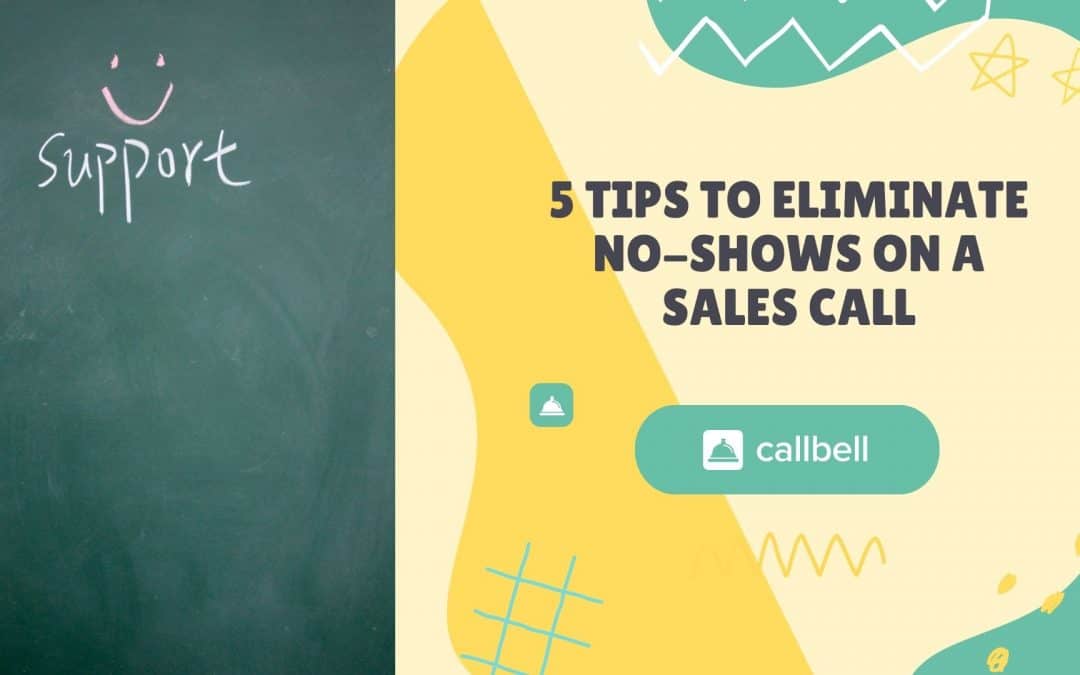The B2B sales environment is not always friendly to salespeople. The truth is that the targets and the pressure they are under day in and day out greatly affects their work. This directly influences their performance and, therefore, they fail to reach their target. That’s when these salespeople get discouraged and end up doing a bad job month after month.
However, despite all of these problems that happen to salespeople when they do their job, they are not as shocking as when a person doesn’t show up for a call or product demo. Just waiting for something to happen is very frustrating.
Waiting and wasting a lead or your time after scheduling a call with a person who seemed interested it’s a fact that all salespeople have to deal with on a daily basis.
Something very interesting and at the same time stressful is that leads don’t notify you. That is, you will never get a message notifying you that your client is not going to attend the demo or the call, there are no emails and this is a major stress load for salespeople.
Few things are more infuriating than investing time in a prospect, only to find out that they are not interested in converting at all.
Sure, if the person doesn’t show up, it’s part of the sales process. But, if this situation has occurred many, many times and has become a regular occurrence, well, maybe it’s time to reconsider what you’re doing.
A no-show is a customer or person who was scheduled to appear on a call or product demo, but never showed up. This type of situation can occur because the no-show person lost interest in a product or service or had something else to do during that time.
While some may have many valid excuses for not showing up, others simply decided the product wasn’t for them and didn’t want to waste any more time.
We know that things can change overnight, some problem or difficulty may arise. A no-show is not always the end of the world. But it is extremely important to understand why this happens, especially when it happens frequently, and to detect if it is our fault or just a coincidence.
Other priorities or occupations
This reason is one of the most common reasons why a No-Show happens. This happens because our potential client does not give the call or presentation the priority it deserves. It can happen that it is intentional and the person simply didn’t want to show up, but it can also happen that something occurs that is out of our hands that doesn’t allow the lead to show up or attend the demo.
When the lead prioritizes something else and not the meeting with you, it happens because they don’t understand the value you can bring to them.
Emergencies or unforeseen events
When the No-show happens for this reason, there is not much to do. Emergencies are just that, emergencies. We can’t avoid coincidences and usually when a lead has an emergency, he loses track of time and fails to focus his attention on what you are presenting to him.
1) Customize and make your demos interactive
According to studies that have been carried out, it has been shown that presentations that are not interactive or that are not personalized and don’t demonstrate the value of the product to the lead, are a waste of time, since the lead never buys or does not end up being interested.
This is because the person never understood the value of the product you are showing them and how it can help them improve their results and their business. Therefore, it is necessary that at the time of making a demo, you personalize it and show your lead how what you are selling will help them, with interactive and original examples.
2) Conduct adequate lead research
The idea of this point, and perhaps one of the most important, is that you should do a thorough research before engaging in a conversation or a call with your lead. This means that you should get to know that person, their likes, their difficulties, what they need. All this with the aim of understanding the problems they present and being able to establish a relationship with that person.
When potential customers trust you it becomes much easier to sell to them. This is why research is essential, it’s also because you can attack that person’s need instantly and avoid beating around the bush or unnecessary words.
3) Clarify the importance of attendance
The idea of this point is that you make the lead understand what they will gain by talking to you, so the person will understand the reason why they should attend the call/demo.
One of the main reasons a person doesn’t show up is because they think the salesperson is only interested in selling to them. When a person thinks the salesperson just wants to sell, they don’t see the value of the product being shown to them. Instead, you should tell them exactly what you want to convey to them in the demo. You can also ask about needs, concerns and create a short list of everything the lead needs to solve and show them how you can do it in the demo.
4) Be decisive and own what you do.
When a salesperson responds or communicates to a prospect that they hope to hear from them in the future or to let them know if they will be available for a meeting at a later date, the prospect is being given the option that they don’t need to show up. This happens because the salesperson is not decisive with what they are communicating to the other person and, therefore, does not show confidence in what they are selling or promoting.
The problem with this type of action is that you leave the decision of the potential client to the prospect and the commitment of the same is not concrete. Consequently, this person can decide to attend when he wants and not when you decide.
To counteract this, you must be decisive, you must show confidence to the client and give them only two options for the meeting time. The idea is to get the potential client to commit to attending and not just ramble on. If in this case the client does not commit then we offer them an alternative or we discard them for not being interested in what we are selling, promoting or commenting on.
5) Follow up with the prospect prior to the demo meeting.
Following up is one of the most important tasks when it comes to connecting with your potential clients, this is done in order not to waste time and attend a meeting where the other party will not show up.
This is why it is extremely important that the day before you follow up with your potential clients and ask them if they are going to attend the demo. This way you can confirm their attendance and fully prepare for the meeting and presentation you will have with that person the next day. This also allows you to better organize your time and plan your content. Moreover, you can use the best AI presentation maker to help you prepare for your presentation without hassle.

Callbell is a great tool to confirm, contact and engage with your potential customers. This multi-agent platform and tool in a nutshell allows you to talk to people from one place on various social networks, such as WhatsApp, Telegram, Instagram and Facebook.
Additionally, it presents different functionalities for sales and support teams such as automation, internal notes, reports, CRM and much more. If you want to know more about Callbell, you can click here.
Frequent Questions
What are some common reasons why a person does not show up for a sales call?
Other priorities or occupations
This reason is one of the most common reasons why a No-Show happens. This happens because our potential client does not give the call or presentation the priority it deserves. It can happen that it is intentional and the person simply didn’t want to show up, but it can also happen that something happens that is out of our hands that doesn’t allow the lead to show up or attend the demo.
When the lead prioritizes something else and not the meeting with you, it happens because they don’t understand the value you can bring to them.
Emergencies or unforeseen events
When the No-show happens for this reason, there is not much to do. Emergencies are just that, emergencies. We can’t avoid coincidences and usually when a lead has an emergency, he loses track of time and fails to focus his attention on what you are presenting to him.
What is a no-show?
A no-show is a customer or person who was scheduled to appear on a call or product demo, but never showed up. This type of situation can occur because the no-show person lost interest in a product or service or had something else to do during that time.
While some may have many valid excuses for not showing up, others simply decided the product wasn’t for them and didn’t want to waste any more time.
About the author: Hello! I am Alan and I am the marketing manager at Callbell, the first communication platform designed to help sales and support teams to collaborate and communicate with customers through direct messaging applications such as WhatsApp, Messenger, Telegram and Instagram Direct




